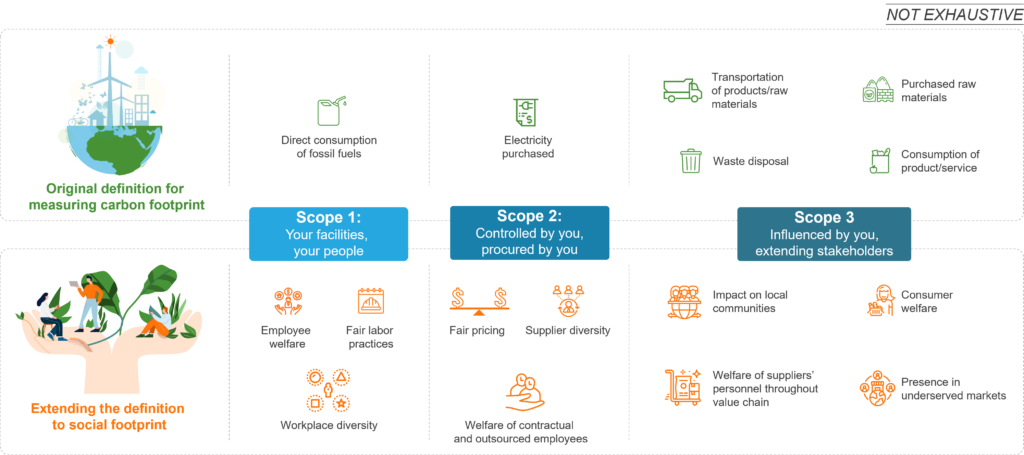
While the decades-old greenhouse gas emissions scopes are a ubiquitous tool for reporting carbon footprints, the reporting standard needs to evolve and extend. Organizations must also measure their impact on people to provide a holistic picture of their sustainability performance. Read on for our new model for extending the global standard of scope 1, 2, and 3.

Scope 1, 2, and 3 emissions explained
More than nine out of ten Fortune 500 companies use the following three scopes to measure, report, and manage their Greenhouse Gas (GHG) emissions:
Scope 1 – your facilities –emissions from fuel sources a company owns and controls
Scope 2 – controlled by you, procured by you –emissions through purchasing electricity
Scope 3 – influenced by you, extending stakeholders –emissions considered indirect to the company due to less control including the supply chain, transportation, and asset portfolios. For many industrial sectors, this is the largest scope
SDGs are comprehensive and all-inclusive, and they do need a comprehensive take on sustainability by enterprises
Sustainable Development Goals, which were adopted in 2015 by the international community, encompass both social and environmental aspects of sustainability. SDGs are witnessing a bigger global collaboration than the Millennial Development Goals (MDGs) and create more space for the private sector’s involvement in realizing the goals. Rooted in human rights, and weaving them with environmental issues, SDGs give a robust opportunity to the private firms to explore their role in slowing down the global warming and making the world a more inclusive space.
With SDGs being a comprehensive take on both social and environmental aspects of sustainability, enterprises need an equally comprehensive outlook on their role in realizing the goals. Enterprises have started zeroing down on their carbon footprint using GHG Protocol. However, they are still falling short on measuring their social footprint and generate the right insight using their social footprint data. While there are several metrices and global standards to measure the social footprint of an organization, these standards are diverse and lack comprehensiveness.
While GHG emissions protocols comprehensively capture an organization’s carbon footprint, a broader focus is required. Expanding these scopes to encompass sustainability’s social aspects will truly serve the aspirational SDGs the world wants to achieve under the United Nations’ 2030 Agenda for Sustainable Development.
Extending the three scopes for success
With this set up, we can all agree the ubiquitous GHG emissions scopes can be extended to include a social footprint for a holistic approach. Using the same logic, we at Everest Group recommend including the following elements in your social scopes:
Scope 1 – your people – A company’s positive and negative influences on employees count towards the social scope 1 footprint. This includes workplace diversity, gender pay gaps, accessibility, employee physical and mental health, parental leave (including maternity, paternity, and adoption benefits), and job security
Scope 2 – controlled by you, procured by you – A company’s positive and negative influence on contractual and outsourced employees, customers (e.g., fair pricing practices), and supplier diversity programs broaden the social footprint.
Scope 3 – influenced by you, extending stakeholders – A company’s wider impact on its customers, supply chain, community, and other stakeholders. It can include:
- Expanded production and services to underserved markets
- Welfare policies for suppliers’ personnel throughout the value chain
- Considering consumer physical and mental well-being in designs
- Providing employment opportunities to local communities
- Ensuring sustainable resource exploitation and value-sharing ecosystem with local communities
- Implementing impactful and relevant CSR initiatives to serve the community
Measuring the total sustainability picture
Although these elements are covered in different national and international laws, standards, and company policies, developing a common definition for social footprints is necessary. Generating indices or scores is one way to measure and rank companies on their performance in these key areas.
In addition to taking into account the people aspects in consolidated ESG scores, the standards should also examine the impact companies have on the planet that goes beyond simply measuring aspects of environmental degradation like deforestation, waste production, and plastic production in siloes.
An international ESG standard should integrate all these elements. Having an integrated ESG score that consolidates the people and planet aspects of sustainability holistically would shed valuable light on a firm’s true sustainability-led values.
With diligence and global collaboration between businesses, governments, and international organizations to develop these standards, the environmental and people aspects of sustainability can be bridged.
What can’t be measured can’t be managed. Everest Group strongly advocates for a comprehensive indexing of enterprises’ social and environmental footprints. With just eight years until 2030, we need to begin evolving our measuring standards now to achieve SDGs in a true sense.
To have scope 1,2, and 3 model explained in greater detail, contact us at [email protected], [email protected], or [email protected].
Learn about Everest Group’s pledge to help organizations around the world increase the number of jobs provided to workers in marginalized communities through impact sourcing – while providing businesses with access to the best talent with high levels of reliability, productivity, and engagement. Our Commitment to Action is to grow the impact sourcing market from its current level of 350,000 FTEs to half a million in three years.








